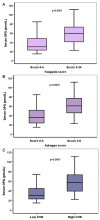Serum OPG and RANKL Levels as Risk Factors for the Development of Cardiovascular Calcifications in End-Stage Renal Disease Patients in Hemodialysis
- PMID: 36836810
- PMCID: PMC9967106
- DOI: 10.3390/life13020454
Serum OPG and RANKL Levels as Risk Factors for the Development of Cardiovascular Calcifications in End-Stage Renal Disease Patients in Hemodialysis
Abstract
Cardiovascular calcifications (CVC) are frequently observed in chronic kidney disease (CKD) patients and contribute to their cardiovascular mortality. The aim of the present study was to investigate the impact of osteoprotegerin (OPG)/Receptor Activator of NF-κΒ (RANK)/RANK ligand (RANKL) pathway in the development and evolution of CVCs in hemodialysis patients. In total, 80 hemodialysis patients were assessed for the presence of vascular (abdominal aorta and muscular arteries) calcifications and results were correlated to serum OPG and RANKL levels and the OPG/RANKL ratio. Traditional cardiovascular risk factors and mineral bone disease parameters were also estimated. The presence of VCs was also evaluated 5 years after the initiation of the study, and results were correlated to the initial serum OPG levels. Age, diabetes mellitus, coronary artery disease and OPG levels (p < 0.001) were associated with VCs, whereas RANKL levels were not. Multivariate analysis though revealed that only OPG levels were significantly associated with abdominal aorta calcifications (p = 0.026), but they were not correlated with the progression of VCs. Serum OPG levels are positively and independently associated with VCs in HD patients, but not with their progression. RANKL levels did not show any associations, whereas further studies are needed to establish the significance of OPG/RANKL ratio.
Keywords: RANKL; cardiovascular calcifications; chronic kidney disease; hemodialysis; osteoprotegerin.
Conflict of interest statement
The authors declare no conflict of interest.
Figures


Similar articles
-
sRANKL/osteoprotegerin complex and biochemical markers in a cohort of male and female hemodialysis patients.J Endocrinol Invest. 2007 Oct;30(9):762-6. doi: 10.1007/BF03350814. J Endocrinol Invest. 2007. PMID: 17993768
-
Osteoprotegerin and osteoprotegerin/TRAIL ratio are associated with cardiovascular dysfunction and mortality among patients with renal failure.Adv Med Sci. 2016 Sep;61(2):269-275. doi: 10.1016/j.advms.2016.03.003. Epub 2016 Mar 21. Adv Med Sci. 2016. PMID: 27128817
-
Circulating levels of osteoprotegerin and receptor activator of NF-kappaB ligand in patients with chronic renal failure.Clin Chem Lab Med. 2007;45(11):1498-503. doi: 10.1515/CCLM.2007.306. Clin Chem Lab Med. 2007. PMID: 17970704
-
Role of the RANK/RANKL/OPG and Wnt/β-Catenin Systems in CKD Bone and Cardiovascular Disorders.Calcif Tissue Int. 2021 Apr;108(4):439-451. doi: 10.1007/s00223-020-00803-2. Epub 2021 Feb 13. Calcif Tissue Int. 2021. PMID: 33586001 Review.
-
CLINICAL Review #: the role of receptor activator of nuclear factor-kappaB (RANK)/RANK ligand/osteoprotegerin: clinical implications.J Clin Endocrinol Metab. 2007 Dec;92(12):4514-21. doi: 10.1210/jc.2007-0646. Epub 2007 Sep 25. J Clin Endocrinol Metab. 2007. PMID: 17895323 Review.
Cited by
-
Circulating osteoprotegerin levels and cardiovascular outcomes in patients with pre-dialysis chronic kidney disease: results from the KNOW-CKD study.Sci Rep. 2024 Feb 19;14(1):4136. doi: 10.1038/s41598-024-54335-y. Sci Rep. 2024. PMID: 38374135 Free PMC article.
References
LinkOut - more resources
Full Text Sources

